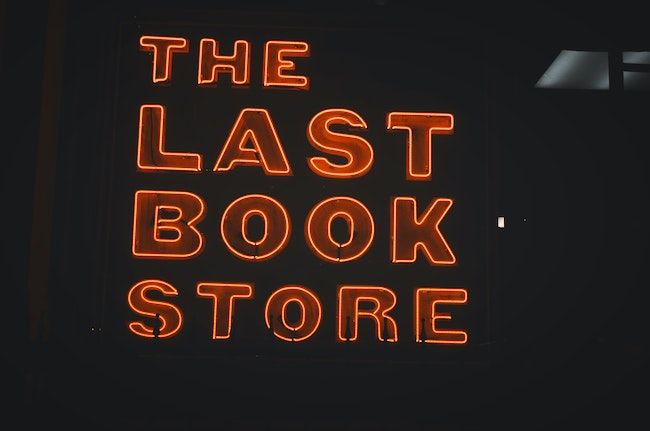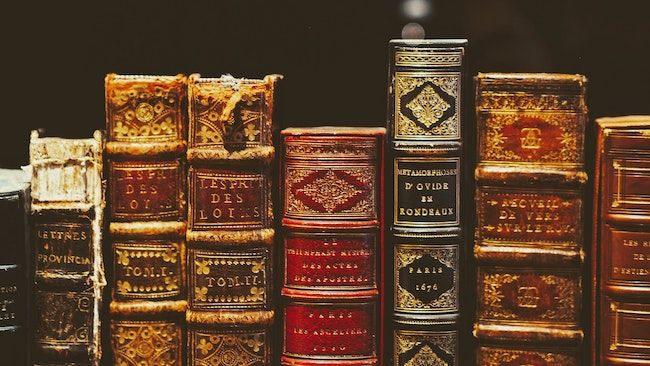Each issue contains an A–Z feature on a topic and no matter what the focus is, I find myself revisiting this particular piece again and again. It’s a highly designed double spread, and always leads me to leaning new things about arts and crafts I never knew before. I wanted to take that idea and see it applied to the book world, running a periodic A–Z feature, and it made perfect sense to begin with the beginning: an A–Z guide to the parts of a book. This A–Z guide includes the internal and external anatomy as it relates to modern books, as well as older books. Indeed, you will know many of these parts, but chances are you’ll pick up a nugget of wisdom or insight you didn’t know, too. This won’t be and isn’t meant to be comprehensive, but rather an opportunity to learn a little bit more about a topic that might inspire you to explore even more.
An A–Z Guide to Parts of a Book
A
Appendix/Appendices: Though these do appear in fiction, the appendix is most common in nonfiction. It’s a place for supplemental information, including research notes, photos, a glossary of terms used throughout the book, and other material that enhances the reading experience or research. Think of appendices as the umbrella term for back matter, as it can include all of the additional information or references for a book, including the bibliography.
B
Binding: How the pages of a book are sewn together. Binding can be done by machine—the most common—but it can also be done by artisans who do it by hand with a variety of techniques. It’s most common for binding to be done with thread or adhesive, but there are other methods used as well (you might be familiar with binder rings or spiral coils like in a notebook).
C
Colophon: Typically in the back of a book, the colophon presents information about the publisher, including where the book was published, when it was published, and even notes about the font type used throughout the book. Colophon can also refer to the image used by a publisher to symbolize their brand: think the penguin for Penguin Books. Not all books have the colophon at the back of the book. It’s pretty common for that information to instead be included on the copyright page.
D
Dedication: Not every book includes a dedication, but an author may choose to honor a friend, family member, or other important person or thing in their life with one. The dedication usually comes on the first right-hand page after the copyright information and the back is typically blank. Numerous authors have earned reputation for clever, creative, and witty dedications over the years.
E
Endpapers: Endpapers, also known as endsheets, are seen in hardcover books and they’re the papers inside the front and back covers. The first page will be pasted down to the cover while the other will be the first page of the book (and vice versa for the endpapers at the back of a book). These may include intricate designs, maps, or be blank. Prior to mass printing and still common in hand binding, the endpapers served as a means of helping fortify the binding of a book. Likewise, in older and rare books, endpapers were created separately from the rest of the pages, allowing for marbling and other creative design.
F
Foreword: Usually written by someone who isn’t the author of a book, the foreword highlights a book’s historical significance, updates to the text in subsequent editions, and/or the writer’s connection to the text to come.
G
Gilding: This decorative technique applies a very thin layer of gold to the page and/or cover edges of a book. Special editions and collector’s editions of books may have gilded edges, and some books even see gilding on an intricately designed front cover. In the earlier days of publishing, the gilding wasn’t just about decoration, though: it served as page protection from moisture and dust.
H
Half-Title Page: A page that features simply the title of the book without the author name or publisher. These aren’t in every book, but you might discover a half-title page in hardcover books on the very first right-hand page of a book after the endpaper. In a paperback, a half-title might appear after the full title page. A half-title page is used when there are excess pages to fill in a book—since a page has four sides to it, the half-title is a means of utilizing potentially empty space at the beginning of a book.
I
Introduction: Unlike a foreward, the introduction to a book is written by the author and can contain insight into the purpose of the book or interesting anecdotes related to the writing but not vital to the text itself. Many times in reissues of books, an author’s introduction can be a reflection of the story or text in its historical and modern context.
J
Joint: The left-hand side of the front book cover and the right-hand side of the back cover that connects the cover to the book’s spine. This is the part of the book many readers like to keep preserved and uncracked, while other readers prefer to crack and pop to show the book it’s being used. The inside of the joint is called the hinge.
K
Kerning: The spacing between font characters. Different fonts have different kernings and the kerning of a font can often be adjusted for a desired effect—you might see this most clearly on a book cover’s title and/or byline.
L
Leaves: Two pages of a book, which is one sheet, is called the leaf. The front of the leaf is the recto while the back of the leave is the verso.
M
Manuscript: The word explains itself: manu-script. It’s a handwritten book. These aren’t especially common today, and the word itself has taken on the meaning of a book which has been written but not published. This is what a writer submits to their agent or publisher that will be edited and made into a book. There have, however, been published manuscripts, particularly when it comes to beloved authors whose work has been published in manuscript form from their archives. Harper Lee’s Go Set a Watchman is an example.
N
Numbers: There are two numbers you’ll often find on a copyright page worth knowing, outside the publisher’s address, copyright year, and the Library of Congress cataloging number. The first is the ISBN, also known as the International Standard Book Number. An ISBN is issued to every edition of a book and is meant to be its unique identifier. The second is the print number. When you look at a copyright page, you might see a list of numbers looking something like this: 3 4 5 1 2. The first number will tell you the the number of printings that particular edition of a book has seen—in the example, that would be the third printing.
O
Octavo: Octavo originally referred to the size of leaves that came from folding of a full sheet of paper with multiple pages of sheets. The octavo had 8 leaves or 16 full pages. In other words, the sheet with text was folded three times to produce 16 pages. Today, though, octavo is less about the printing format and instead about the size of a book: about 8–10 inches tall, or your standard hardcover and trade paperback book. It may or may not be made from octavo style folding.
P
Prologue: Typically limited to fiction or narrative nonfiction, the prologue sets the stage for the book, opening the reader to the setting or background necessary to begin. It’s usually told through the perspective of the book’s narrator or a character in the story.
Q
Quotation: Many books utilize a quotation either at the beginning of the book or at the beginning of various chapters within the book that wasn’t written by the author of the text. Its technical name is an epigraph.
R
Raised Bands: This isn’t seen much in book binding today except as a decorative element, but in the early days of binding books, the cords used to sew pages together would not be flush with those pages. The spine, which was attached later in the process, needed to accommodate those cords and thus, the raised bands on spines (See image below!)
S
Spine: This is the outside case of the binding—the place where all of the pages are bound together and the part of the book which sticks out on a shelf. Sometimes the spine is flush with the paper and other times it’s not. In many hardcover books, you might see a threads at the top or bottom of the pages inside a spine. Called the headband or tailband, these help protect the space between the block of bound pages and the spine.
T
Text Block: Sometimes also called a book block, this is the stack of pages which comprise the book. Binding is typically sewn on one end, with a spine and boards (covers) on the outside.
U
Uncut: You might be more familiar with the term deckle edge. Uncut/deckle edges refer to pages which haven’t been trimmed and made uniform on the text block that is not bound. Uncut can also refer to the old practice of books being unbound upon acquisition, and once purchased, the owner would then seek out their own binder for the pages. The uncut pages were what existed before the binder would then cut and trim the text block to fit the binding. Here’s a bit of history about uncut/deckle edges.
V
Volume: Volume refers to leaves which are bound together. Each stand alone book is a volume, though the term tends to be used most frequently with multiple books within a series. In anthologies or larger collections of work, multiple volumes may be collected in a single book.
W
Wrap: As in dust wrapper or dust jacket, the history of this part of a book is fascinating. Once used to protect the hardcover of a book from dust, scratches, and other damage, after World War II, publishers realized that dust wrappers could be a vital part of a book’s marketing. Today, they’re highly designed and meant to capture a reader’s eye more than protect the covers.
X
X: Typically the mark used on a book’s call number or other identification code in a library or bookstore that denotes it as a discard. It may also indicate page 10 in Roman Numerals.
Y
Yellow Back: Cheap, sensationalist novels produced en mass during the Victorian Era in England, called yellow backs, were developed to compete with penny novels. The books were covered in yellow paper to make them pop and catch the attention of anyone passing by—which was, of course, the goal, as these yellow backs were most commonly seen in high-traffic areas like train stations. Yellow backs as a term is still in use today to describe similar books with little or no quality to them, but it’s rare to hear.
Z
Zero: The approximate number of parts of a book beginning with the letter “z.” An alternate entry goes to zine, though a zine is a type of reading material, as opposed to part of the anatomy of reading material. That said, get to know about what zines are and why they matter.































































